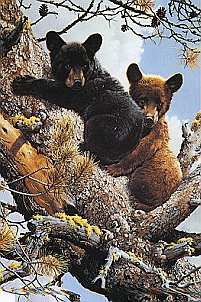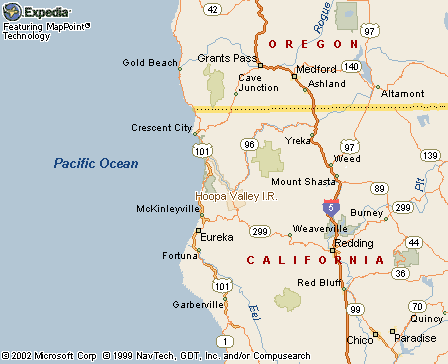|
|
Canku Ota |
|
|
(Many Paths) |
||
|
An Online Newsletter Celebrating Native America |
||
|
August 24, 2002 - Issue 68 |
||
|
|
||
|
Bears Dine on Trees - Rob Tribe of Revenue |
||
|
By Emily Gurnon -- Bee
Correspondent
|
||
|
credits: art by
Carl Brenders
|
 HOOPA
VALLEY INDIAN RESERVATION -- The female bear snaps and growls from inside
the trap. Her captors whisper, coo and -- when the animal is sedated --
gently stroke her fur. "So pretty," one says. HOOPA
VALLEY INDIAN RESERVATION -- The female bear snaps and growls from inside
the trap. Her captors whisper, coo and -- when the animal is sedated --
gently stroke her fur. "So pretty," one says.
The kind treatment reflects the Hoopa Indians' traditional reverence for the American black bears, animals they consider their cousins. But that close relationship has been strained in recent years as the bears have increasingly helped themselves to the tribe's No. 1 resource: trees. Instead of inviting hunters to shoot the tree-stripping bears, as government agencies and private landowners have done throughout the Pacific Northwest, the Hoopa have taken a different approach. They've begun a long, painstaking and expensive study that includes genetic identification of the problem bears, trapping, tagging -- and even dental exams. "We're working on establishing which bears are 'good' bears and which are 'bad' bears," said Aaron Pole, a Hoopa tribal member and wildlife technician with Hoopa Tribal Forestry. Logging of Douglas fir trees on the Humboldt County reservation, 110 miles northwest of Redding, generates nearly all of the revenue for the 2,200-member tribe and has for decades, said Mark Higley, wildlife biologist at Hoopa. Bears are abundant there, numbering more than 400 on the 144 square miles. Certain of those bears strip the bark from trees to eat the sugary cambium layer underneath. Once enough of the bark is removed, the tree dies. Tree-stripping is nothing new; bears have been doing it since at least the early part of the 20th century, scientists have observed. The tribe saw it on the reservation for the first time in 1978. Since then, the phenomenon has mushroomed, spreading from one small plot in the northwest part of the reservation to the entire west side. "We find some spots where 50 trees were all stripped in the last day or two," Higley said. The areas where trees have been thinned to promote growth are especially vulnerable. "The bears go in there and just wipe things out after that," he said. Hoopa officials estimate the damage may drain $1 million to $2 million, or at least 15 percent, this year from their timber revenues. The tribe has considered several options for dealing with the problem, including charging hunters to take guided tours through the reservation and shoot the bears. But because it was deemed potentially ineffective -- and because it could be met with resistance from tribal members -- that option was nixed. The Hoopa themselves are not restricted from shooting bears, but the cultural tradition against it is so strong that few do.
On a recent weekday, the workers headed out to a trap that had snared a 130-pound female, one of about 100 bears this season that will be captured. After the bear was anesthetized, Pole opened one end of the large tube and gently gathered her in his arms, pulling her out onto a stretcher. The animal was weighed and measured. Workers took photos of her teeth from several angles. Jaime Sajecki, a graduate student in wildlife management from Humboldt State University, carefully measured the bear's teeth and recorded details about their condition. She is working with Higley's team to gather data for their thesis: that bears that are stripping trees will have worse teeth than other bears. "Our theory is the tooth decay that we see is a result of cramming that stuff in between their incisors," Higley said. "They do that for two months and don't floss." The relationship has never before been documented, he said. In the meantime, the team tags each bear and takes a hair sample. The hair is tested. If it matches a sample from a stripped tree, the bear goes on the "targeted" list. Then it must be caught a second time -- a rare stroke of luck for the trappers. At that point, it will be killed, as four have been this year. That final result is one that disturbs Pole and others. "Every single time we had to catch a bear and put one down, I was almost losing sleep over it," he said. "But you see a whole acre of trees gone -- maybe it's for the best. These are the trees that are going to support my people in the future."
|
|
|
||
|
|
||
| Canku Ota is a free Newsletter celebrating Native America, its traditions and accomplishments . We do not provide subscriber or visitor names to anyone. Some articles presented in Canku Ota may contain copyright material. We have received appropriate permissions for republishing any articles. Material appearing here is distributed without profit or monetary gain to those who have expressed an interest. This is in accordance with Title 17 U.S.C. section 107. | ||
|
Canku Ota is a copyright © 2000, 2001, 2002 of Vicki Lockard and Paul Barry. |
||
 |
 |
|
|
The "Canku Ota - A Newsletter Celebrating Native America" web site and its design is the |
||
|
Copyright © 1999, 2000, 2001, 2002 of Paul C. Barry. |
||
|
All Rights Reserved. |
||
 Instead,
acting on the assumption that tree-stripping is a learned behavior practiced
only by certain bears, tribal forestry workers regularly scour stripped
trees for bear hairs, which are sent to a Canadian lab for genetic analysis.
Two hundred samples are collected each year. Then they monitor the six
culvert traps -- which look like large metal drain pipes -- positioned
throughout the reservation.
Instead,
acting on the assumption that tree-stripping is a learned behavior practiced
only by certain bears, tribal forestry workers regularly scour stripped
trees for bear hairs, which are sent to a Canadian lab for genetic analysis.
Two hundred samples are collected each year. Then they monitor the six
culvert traps -- which look like large metal drain pipes -- positioned
throughout the reservation.